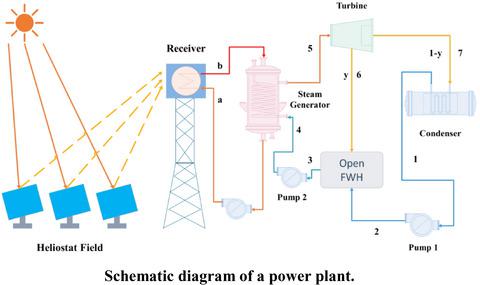当前位置:
X-MOL 学术
›
Energy Sci. Eng.
›
论文详情
Our official English website, www.x-mol.net, welcomes your feedback! (Note: you will need to create a separate account there.)
Novel analysis of second law and irreversibility for a solar power plant using heliostat field and molten salt
Energy Science & Engineering ( IF 3.8 ) Pub Date : 2020-09-25 , DOI: 10.1002/ese3.802 Mohammad Hossein Zolfagharnasab 1 , Cyrus Aghanajafi 1 , Soheil Kavian 2 , Niloufar Heydarian 1 , Mohammad Hossein Ahmadi 3
Energy Science & Engineering ( IF 3.8 ) Pub Date : 2020-09-25 , DOI: 10.1002/ese3.802 Mohammad Hossein Zolfagharnasab 1 , Cyrus Aghanajafi 1 , Soheil Kavian 2 , Niloufar Heydarian 1 , Mohammad Hossein Ahmadi 3
Affiliation

|
Nowadays, the low efficiency of solar energy power plant systems brings about uneconomical performance and high‐cost uncompetitive industries compared with the traditional fossil fuel ones. In order to overcome these kinds of issues, in this study, the performance of a solar tower coupled with a Rankine cycle is scrutinized using the first and second laws of thermodynamic. Moreover, a numerical code has been developed in the GNU Octave software environment to calculate the precise value for both energy and exergy losses of each component. Furthermore, the sensitivity analysis approach corresponds to the variation of several inner parameters such as direct normal irradiation (DNI), molten salt outlet temperature (MSOT), and the molten salt velocity (MSV), environmental parameters such as wind speed and ambient temperature have been performed. In addition, the overall losses are calculated by considering all possible forms of losses such as convection, conduction, reflection, and emission, and also, the portion of each source of these losses are determined. The obtained results indicate that the maximum exergy loss occurs in the central receiver system (CRS), while the major energy loss occurs in the turbine located in the power block. The sensitivity analysis shows that the rise of DNI significantly increases the exergy%energy efficiency of the cycle and also, the portion of loss related to emission heat transfer would be enhanced. Moreover, the variation of the MSV and MSOT illustrate influencing the performance of the cycle; consequently, the MSOT changes demonstrate a reverse relation with energy and direct relation with exergy efficiency. Accordingly, an optimum value of 650K is calculated for the MSOT as well as an optimum value of 2 m%s for the MSV. The environmental sensitivity analysis indicates that the enhancement of wind speed and ambient temperature has a negative impact on the net output of the cycle, which is not desirable.
中文翻译:

使用定日镜场和熔融盐对太阳能发电厂的第二定律和不可逆性进行新颖分析
如今,与传统的化石燃料相比,太阳能发电厂系统的低效率带来了不经济的性能和高成本,缺乏竞争力的产业。为了克服这些问题,在这项研究中,使用热力学的第一定律和第二定律仔细研究了具有兰金循环的太阳能塔的性能。而且,已经在GNU Octave软件环境中开发了一个数字代码,以计算每个组件的能量和火用损失的精确值。此外,灵敏度分析方法对应于多个内部参数(例如直接法线辐射(DNI),熔融盐出口温度(MSOT)和熔融盐速度(MSV))的变化,环境参数(例如风速和环境温度)具有被执行。另外,通过考虑所有可能的损耗形式(例如对流,传导,反射和发射)来计算总损耗,并确定这些损耗的每个来源的比例。获得的结果表明,最大的火用损失发生在中央接收器系统(CRS)中,而主要的能量损失发生在位于动力块中的涡轮机中。灵敏度分析表明,DNI的上升显着提高了循环的火用%能量效率,并且,与排放传热有关的损失部分也将增加。此外,MSV和MSOT的变化说明了对循环性能的影响。因此,MSOT的变化与能量呈反比关系,与火用效率成正比关系。因此,MSOT的最佳值为650K,MSV的最佳值为2 m%s。环境敏感性分析表明,风速和环境温度的提高会对循环的净输出产生负面影响,这是不希望的。
更新日期:2020-11-16
中文翻译:

使用定日镜场和熔融盐对太阳能发电厂的第二定律和不可逆性进行新颖分析
如今,与传统的化石燃料相比,太阳能发电厂系统的低效率带来了不经济的性能和高成本,缺乏竞争力的产业。为了克服这些问题,在这项研究中,使用热力学的第一定律和第二定律仔细研究了具有兰金循环的太阳能塔的性能。而且,已经在GNU Octave软件环境中开发了一个数字代码,以计算每个组件的能量和火用损失的精确值。此外,灵敏度分析方法对应于多个内部参数(例如直接法线辐射(DNI),熔融盐出口温度(MSOT)和熔融盐速度(MSV))的变化,环境参数(例如风速和环境温度)具有被执行。另外,通过考虑所有可能的损耗形式(例如对流,传导,反射和发射)来计算总损耗,并确定这些损耗的每个来源的比例。获得的结果表明,最大的火用损失发生在中央接收器系统(CRS)中,而主要的能量损失发生在位于动力块中的涡轮机中。灵敏度分析表明,DNI的上升显着提高了循环的火用%能量效率,并且,与排放传热有关的损失部分也将增加。此外,MSV和MSOT的变化说明了对循环性能的影响。因此,MSOT的变化与能量呈反比关系,与火用效率成正比关系。因此,MSOT的最佳值为650K,MSV的最佳值为2 m%s。环境敏感性分析表明,风速和环境温度的提高会对循环的净输出产生负面影响,这是不希望的。



























 京公网安备 11010802027423号
京公网安备 11010802027423号